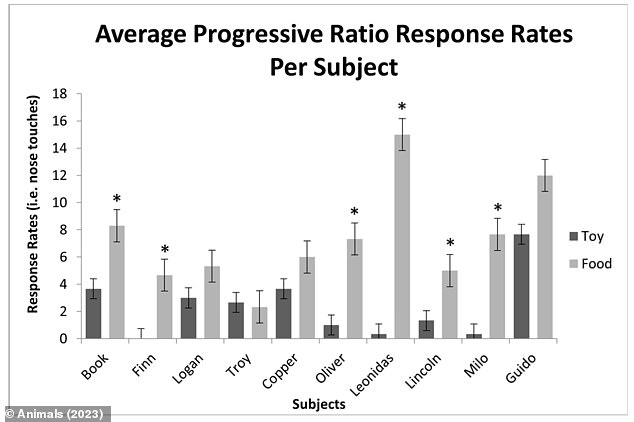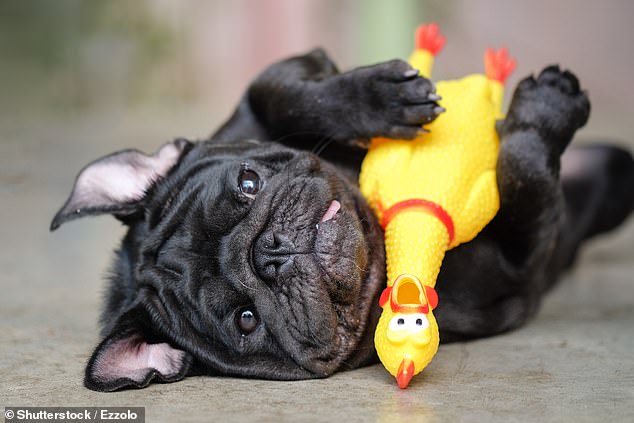Bone appetit! Dogs prefer food over toys, study confirms
Whether it’s a squeaky ball or a fluffy stuffed toy, many dogs have a favorite toy.
But a new study has found that these toys take a back seat to 90 percent of puppies – when food is involved.
Researchers from the University of Florida found that nine out of ten dogs prefer food over toys.
In the study, the team compared the favorite foods and favorite toys of ten dogs, and found that the vast majority responded more strongly to the food.
Dr. Nicole Dorey, lead author of the study, said: ‘I was surprised, but no one has previously looked at how dogs will work for toys versus food.’

Whether it’s a squeaky ball or a fluffy stuffed toy, many dogs have a favorite toy. But a new study has found that these toys take a backseat to 90 percent of puppies – when food is involved (stock image)

The team compared the favorite foods and favorite toys of ten dogs and found that the vast majority responded more strongly to the food
Although previous studies have shown that dogs prefer their favorite people over food, little research has been done to date on how dogs prioritize their favorite toys.
To set the record straight, the team recruited ten dogs from a range of breeds, including two German Shepherds, a German Shorthaired Pointer, a Labrador and six mixed breeds.
The dogs were shown six food items – hot dogs, carrots, cheese, kibble, a hard dog treat or a soft dog treat – and six toys, including a tennis ball, a tug toy, a squeaky toy and an empty water bottle. .
Each dog was then given the opportunity to choose his favorite toy and his favorite food.
In a follow-up experiment, the dogs were given increasingly difficult tasks to earn a reward: their favorite food or favorite toy.
The results showed that nine out of ten dogs were more likely to abandon the task when presented with the toy than when presented with their favorite treat.
This suggests that they are willing to work harder for food than for toys.
The researchers hope the findings can be useful to dog owners trying to train their pets.
“You can definitely train your dog with toys if you start very early,” said Dr. Dorey.
“This is what they do with search and rescue dogs, they start very early with toys as a reinforcer.”

The results showed that nine out of ten dogs were more likely to abandon the task when presented with the toy than when presented with their favorite treat (stock image)
The study comes shortly after research found that giving anxious dogs a toy to chew on can help improve their memory.
American researchers assessed the performance of 34 Labrador retrievers on a working memory task, which required them to remember which bucket a treat had been placed in over a short period of time.
The dogs were given a chew toy to bite on for five minutes just before the task, and the frequency of the bites was recorded by a computer program.
Before the experiment, trainers who had worked with the dogs for at least a month completed the Canine Behavioral Assessment and Research Questionnaire to rate each dog’s level of “anxiety.”
The researchers from Auburn University in Alabama found: ‘In dogs with high anxiety, more frequent chewing when given access to a chew toy was associated with better spatial working memory, while the opposite was true for dogs with low anxiety.’
It is thought that chewing in anxious dogs may reduce physiological arousal, allowing them to concentrate, while chewing may cause distraction in more relaxed dogs.
